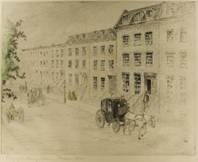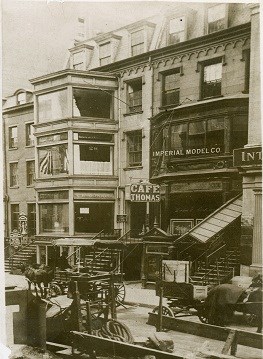
Theodore Roosevelt's grandfather, Cornelius Van Schaack "CVS" Roosevelt, grew very wealthy from his successful plate glass importing business. His business, Roosevelt and Son, was located on Maiden Lane. In the 1830s, CVS moved his family uptown to Union Square and built a mansion on Broadway. The property which from 13th to 14th Street. CVS followed the trend of prominent New Yorkers pushing northward and establishing themselves in fashionable residential areas that were then the outskirts of a growing city. 
The term "brownstones" referred to both the prized architectural style and building material. The Romantic movement of the early to mid-1800s, expressed by Henry Thoreau, Ralph Waldo Emerson, and Walt Whitman, advocated a return to nature in architecture. Brownstone, or brownsandstone, was found suitable, with its warm color and ease of carving. Its availability in Ohio, New York, Pennsylvania, Connecticut, and New Jersey allowed for easy transportation via water and rail. At the same time, there was less land available as the population grew, favoring "row houses" which were attached to their neighbors, sharing common walls. The simple exterior of brownstones clashed with the decorative interiors of the Victorian era of 1837 to 1901, although the wealthy adopted the long rows of identical houses. Some rejected this style, such as Edith Wharton, a contemporary of TR, who lived not far from No. 28 in a similar brownstone in Gramercy Park. Wharton expresses in Age of Innocence her skepticism of the uniformity of New York society in its architecture. The layouts of brownstones followed a pattern. They had a tall stoop which led to a front door that opened on the second floor into a long narrow hall, a parlor in the front, a dining room at the rear, the bedrooms upstairs, and the kitchens and servant quarters in the ground floor basement, which had its own servants' entrance. The brownstone of Theodore Roosevelt's family had this layout. 
By the late 1800s, brownstones were going out of fashion and a commercial tide arrived in the neighborhood of the Roosevelt family. In 1873, following the continual trend of northward migration, Theodore Sr. moved his family to a mansion at No. 6 West 57th Street, just below Central Park and next door to Theodore Roosevelt's uncle James. Theodore was fourteen years old. The brownstone where Theodore Roosevelt was born on 20th St. was sold. At first, bay windows were added to the five-story brownstone when it became a store in 1896; it was then completely demolished to make way for a two-story retail structure in 1916. Three years later, Theodore Roosevelt died. His family bought the store and the uncle's original brownstone next door. They rebuilt the sites into a replica of Theodore Roosevelt's Birthplace circa 1865, with five period rooms, two exhibit galleries, and an auditorium. It opened in 1923 as "The Roosevelt House." It was privately run by the Women's Roosevelt Memorial Association (WRMA) until 1962, when it became a Theodore Roosevelt Birthplace National Historic Site (NHS), administered by the National Park Service. 

|
Last updated: March 2, 2025

